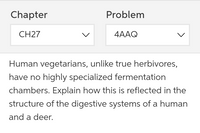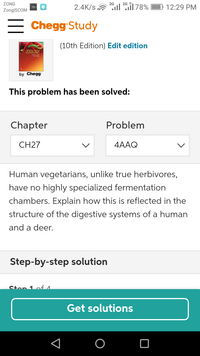
Human Anatomy & Physiology (11th Edition)
11th Edition
ISBN: 9780134580999
Author: Elaine N. Marieb, Katja N. Hoehn
Publisher: PEARSON
expand_more
expand_more
format_list_bulleted
Question
Human vegetarians, unlike true herbivores , have no highly specialized fermentation chamber , Explain How is this reflected in the structure of

Transcribed Image Text:Chapter
Problem
CH27
4AAQ
Human vegetarians, unlike true herbivores,
have no highly specialized fermentation
chambers. Explain how this is reflected in the
structure of the digestive systems of a human
and a deer.
>

Transcribed Image Text:ZONG
2G
2G
2.4K/s ll il 78%
12:29 PM
Zong|SCOM
= Chegg Study
(10th Edition) Edit edition
ZOOLOGY
by Chegg
This problem has been solved:
Chapter
Problem
CH27
4AAQ
Human vegetarians, unlike true herbivores,
have no highly specialized fermentation
chambers. Explain how this is reflected in the
structure of the digestive systems of a human
and a deer.
Step-by-step solution
Ston 1 of A
Get solutions
Expert Solution
This question has been solved!
Explore an expertly crafted, step-by-step solution for a thorough understanding of key concepts.
This is a popular solution
Trending nowThis is a popular solution!
Step by stepSolved in 3 steps

Knowledge Booster
Learn more about
Need a deep-dive on the concept behind this application? Look no further. Learn more about this topic, biology and related others by exploring similar questions and additional content below.Similar questions
- Explain the process that is depicted by the diagram below. (What is the overall purpose of the process?What kind of organism uses this process? What is the overall significance of this process to life? *please answer the question being asked. answer should be short and concisearrow_forwardSelect the statement that is NOT correct O Most plasma lipoproteins are synthesised in the liver O The enzymatic complement of liver tissue changes in response to changes in the diet The liver synthesises most of the urea produced in the body The presence of glucose-6-phosphatase makes the liver uniquely able to release glucose into the bloodstream O Under certain conditions, other organs can perform most of the functions of the liverarrow_forwardAfter a meal that contains carbohydrates, blood glucose levels usually rise gradually as carbohydrates are digested and the resulting monosaccharides are absorbed into the bloodstream. Suppose you run a test on a human with no lactase production. You would provide a dose (e.g., 25 grams) of lactose and measure changes in blood glucose levels over the next three hours. Predict how blood glucose levels would change from fasting to three hours. Justify your response using the results from the above simulation.arrow_forward
- Bats mostly hunt insects at night. They are able to determine the distance and speed of any prey they are chasing, which has helped them to become excellent nocturnal predators. One potential prey, the tiger moth, has developed two separate methods of evading predation. First, tiger moths emit a toxin that is distasteful to bats, birds, and most other vertebrate predators. Second, they use an organ called a "tymbal" to create a series of high-pitched clicks that only bats can hear, and which identify the tiger moths as something the bats don't like to eat. Bats who prey on tiger moths discover they don't taste very good, learn to identify tiger moths by their clicks, and avoid eating them. Use this information to answer the questions below. Question 1: The scenario above describes a distinct evolutionary interaction. What is it?Can you explain? Question 2: Why is it necessary for the moth to produce both a tymbal click and a toxin? Why not just a toxin? Do you think there are…arrow_forwardon a molecular level explain what enables the interaction of salivary amylase and starch in potatoarrow_forwardNADH boosts gluconeogenesis in the liver. So, what do you think about this assertion?arrow_forward
- Mammals in the Arctic Circle such as reindeer have higher levels of unsaturated fatty acids in the cell membranes in their legs than in other parts of their bodies. Suggest a reason for this phenomenon. Does it have a survival advantage?arrow_forwardDescribe the glucose oxidation equation and use it to explain why animals are inefficient systems.arrow_forward
arrow_back_ios
arrow_forward_ios
Recommended textbooks for you
 Human Anatomy & Physiology (11th Edition)BiologyISBN:9780134580999Author:Elaine N. Marieb, Katja N. HoehnPublisher:PEARSON
Human Anatomy & Physiology (11th Edition)BiologyISBN:9780134580999Author:Elaine N. Marieb, Katja N. HoehnPublisher:PEARSON Biology 2eBiologyISBN:9781947172517Author:Matthew Douglas, Jung Choi, Mary Ann ClarkPublisher:OpenStax
Biology 2eBiologyISBN:9781947172517Author:Matthew Douglas, Jung Choi, Mary Ann ClarkPublisher:OpenStax Anatomy & PhysiologyBiologyISBN:9781259398629Author:McKinley, Michael P., O'loughlin, Valerie Dean, Bidle, Theresa StouterPublisher:Mcgraw Hill Education,
Anatomy & PhysiologyBiologyISBN:9781259398629Author:McKinley, Michael P., O'loughlin, Valerie Dean, Bidle, Theresa StouterPublisher:Mcgraw Hill Education, Molecular Biology of the Cell (Sixth Edition)BiologyISBN:9780815344322Author:Bruce Alberts, Alexander D. Johnson, Julian Lewis, David Morgan, Martin Raff, Keith Roberts, Peter WalterPublisher:W. W. Norton & Company
Molecular Biology of the Cell (Sixth Edition)BiologyISBN:9780815344322Author:Bruce Alberts, Alexander D. Johnson, Julian Lewis, David Morgan, Martin Raff, Keith Roberts, Peter WalterPublisher:W. W. Norton & Company Laboratory Manual For Human Anatomy & PhysiologyBiologyISBN:9781260159363Author:Martin, Terry R., Prentice-craver, CynthiaPublisher:McGraw-Hill Publishing Co.
Laboratory Manual For Human Anatomy & PhysiologyBiologyISBN:9781260159363Author:Martin, Terry R., Prentice-craver, CynthiaPublisher:McGraw-Hill Publishing Co. Inquiry Into Life (16th Edition)BiologyISBN:9781260231700Author:Sylvia S. Mader, Michael WindelspechtPublisher:McGraw Hill Education
Inquiry Into Life (16th Edition)BiologyISBN:9781260231700Author:Sylvia S. Mader, Michael WindelspechtPublisher:McGraw Hill Education

Human Anatomy & Physiology (11th Edition)
Biology
ISBN:9780134580999
Author:Elaine N. Marieb, Katja N. Hoehn
Publisher:PEARSON

Biology 2e
Biology
ISBN:9781947172517
Author:Matthew Douglas, Jung Choi, Mary Ann Clark
Publisher:OpenStax

Anatomy & Physiology
Biology
ISBN:9781259398629
Author:McKinley, Michael P., O'loughlin, Valerie Dean, Bidle, Theresa Stouter
Publisher:Mcgraw Hill Education,

Molecular Biology of the Cell (Sixth Edition)
Biology
ISBN:9780815344322
Author:Bruce Alberts, Alexander D. Johnson, Julian Lewis, David Morgan, Martin Raff, Keith Roberts, Peter Walter
Publisher:W. W. Norton & Company

Laboratory Manual For Human Anatomy & Physiology
Biology
ISBN:9781260159363
Author:Martin, Terry R., Prentice-craver, Cynthia
Publisher:McGraw-Hill Publishing Co.

Inquiry Into Life (16th Edition)
Biology
ISBN:9781260231700
Author:Sylvia S. Mader, Michael Windelspecht
Publisher:McGraw Hill Education